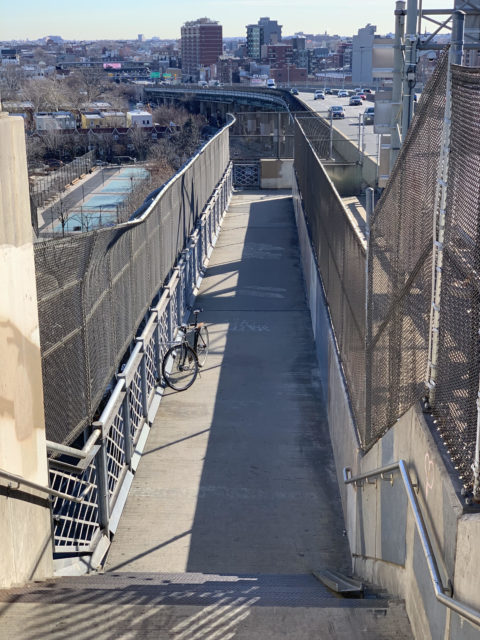January 17, 2023
Inside the MTA’s new plan for bicycle access
The MTA released its first-ever “Strategic Action Plan to Promote Bicycle, Pedestrian and Micromobility Access to MTA Facilities” on January 11. The plan contains big news for bike access to MTA bridges and marks a key pivot in MTA thinking about how people reach mass transit stations across the New York region.
If you haven’t followed this story, in early 2021, Bike New York and StreetsPAC proposed legislation requiring the MTA to develop a plan for bicycle access to MTA bridges and for bike parking at transit stations. Thanks to stellar work by legislative sponsors State Senator Alessandra Biaggi and Assemblymember Jessica González-Rojas, the legislation was approved and signed by Governor Hochul that December.
The MTA worked throughout 2022 to develop the plan. In October, it lifted restrictions on biking over the Cross-Bay/Veterans Memorial Bridge between the Rockaways and Broad Channel. It also announced plans for a full bikeway on the lower level of the Henry Hudson Bridge by 2024.
What’s new:

The Triborough path today.
Last week’s release of the full plan added the very welcome news that the MTA plans to replace the north-side walkway and stairs on the main Triborough/RFK span between Queens and Randalls/Wards Islands. MTA says it will award a large-scale contract for this work. In transportation jargon, the work will produce an “AASHTO compliant shared use path” on the main Triborough Bridge. AASHTO minimum width for a shared use path, as interpreted by the NY State Bridge Manual, is 12 feet. MTA estimates the work to take four and a half years. The MTA also expects to reopen the northern path on the Manhattan/Randall’s span of the Triborough by 2026, which is being rebuilt today with full ramps with a direct connection to the East River esplanade.
The plan also revives the idea of adding bicycle access to the Verrazzano Bridge. It lists a lot of engineering preconditions for doing so, but we’re glad it’s laid out rather than left in a vague future point. Unlike NYC DOT, the MTA currently appears unwilling to consider converting bridge traffic lanes to bike use. The Henry Hudson plan will use a part of the roadway that is marked off from active driving.
In the meantime, the plan commits the MTA to adding bike racks on buses running the S79 (Verrazzano), Q44 (Whitestone), and M60 (Triborough) routes. Racks are already on S53, S93, Q50, and Bx23 buses. The MTA says it is considering racks on Q35 buses across the Marine Parkway Bridge.
Looking ahead:
The MTA plan is less specific with regard to bike parking at transit. That is partly because there is no template for secure bike parking in NYC. NYC DOT says it is developing a proposal for secure bike parking installations, and bike parking at many subway stops will require city action. The MTA says it will install more bike racks on its own property – primarily at commuter rail stops – and explore secure bike parking.
The plan includes more, like looking ahead to changes such as integrating CitiBike into the OMNY payment system and the dull but critical integration of biking considerations into MTA maintenance, budgeting, and project design procedures.
Overall, we’re really pleased with the plan. The MTA could have dragged its feet in this area but instead took the legislation as an opportunity to turn a major policy corner. Combining cycling and transit is one of the most effective sustainable transportation strategies across the world. Opening more direct bike routes with new and improved bridge facilities in New York City will strongly support increased bike use for travel, fun, and commerce.
Thanks to all of our members and supporters who helped move the legislation through Albany and who weighed in on the MTA’s bike/pedestrian plan portal this year! Of course, we’ll watch closely as pieces of the plan move ahead.
Written by Jon Orcutt.

